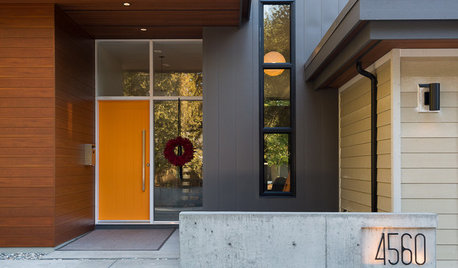Maintenance : Development
edzard
18 years ago
Related Stories

KITCHEN COUNTERTOPSKitchen Counters: High-Tech Solid Surfaces Make Maintenance Easy
Sculpted by heat and nonporous by nature, solid-surface countertops bring imagination and low maintenance to the kitchen
Full Story
CURB APPEALEntry Recipe: Low-Maintenance Meets Contemporary Curb Appeal in Canada
A neighborhood-appropriate mix of textures and colors invites visitors to linger as they approach
Full Story
KITCHEN COUNTERTOPS7 Low-Maintenance Countertops for Your Dream Kitchen
Fingerprints, stains, resealing requirements ... who needs ’em? These countertop materials look great with little effort
Full Story
MOST POPULARA First-Time Buyer’s Guide to Home Maintenance
Take care of these tasks to avoid major home hassles, inefficiencies or unsightliness down the road
Full Story
LANDSCAPE DESIGN7 Low-Maintenance Lawn Alternatives
Turf isn't the only ground cover in town. Get a lush no-grass lawn with clover, moss and other easy-care plants
Full Story
GARDENING GUIDESGreat Design Plant: Rosa Banksiae a Low-Maintenance Beauty
This thornless, disease- and insect-resistant rose brings showers of white or yellow flowers to the spring garden
Full Story
MONTHLY HOME CHECKLISTSYour Spring Home Maintenance Checklist
When winter weather departs, it’s time to check for damage and prepare for warm days ahead
Full Story
MONTHLY HOME CHECKLISTSYour Fall Home Maintenance Checklist
Prep your house and yard for cold weather with this list of things to do in an hour or over a weekend
Full Story
COMMUNITYIn L.A.’s Echo Park, a New Urban Development Takes Flight
Blackbirds, a new ‘microneighborhood’ near downtown, is Los Angeles’ latest small-lot urban infill project
Full Story
GREEN BUILDINGHouzz Tour: Sea Ranch Gets a New LEED Platinum Neighbor
Oceanfront living goes sustainable in a most stunning way, in a renowned California development
Full Story





DonPylant
edzardOriginal Author
Related Professionals
New Bedford Landscape Architects & Landscape Designers · Accokeek Landscape Architects & Landscape Designers · Hartford Landscape Contractors · Deerfield Landscape Contractors · Dudley Landscape Contractors · El Reno Landscape Contractors · Melrose Park Landscape Contractors · Oxnard Landscape Contractors · Wanaque Landscape Contractors · Tyngsboro Landscape Contractors · Columbia Decks, Patios & Outdoor Enclosures · Dearborn Decks, Patios & Outdoor Enclosures · Del Aire Decks, Patios & Outdoor Enclosures · Livingston Decks, Patios & Outdoor Enclosures · Pittsburgh Decks, Patios & Outdoor Enclosuresinkognito
edzardOriginal Author
inkognito
edzardOriginal Author
DonPylant
Archer55
inkognito
SilverVista
DonPylant
inkognito
DonPylant
jeepster
edzardOriginal Author
SilverVista
edzardOriginal Author
SilverVista
edzardOriginal Author
SilverVista
ron_s
ScottReil_GD
edzardOriginal Author